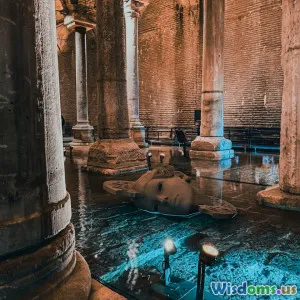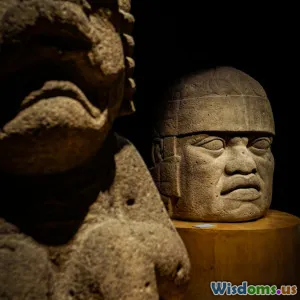
Cave Art: A Window into the Past
7 min read Discover how cave art unlocks secrets of ancient lives, cultures, and beliefs through stunning prehistoric murals and engravings. (0 Reviews)
Cave Art: A Window into the Past
Introduction
Imagine stepping into a dimly lit cave where the flickering glow of a torch illuminates primitive drawings etched into the stone walls. These scenes, created tens of thousands of years ago, are not mere doodles but profound records of early human expression. Cave art captivates us because it connects modern observers with our ancient ancestors in an intimate dialogue across millennia.
Far from childish sketches, these are considered some of humanity’s earliest attempts to understand and communicate about the world. From evoking spirituality to narrating daily life, cave art serves as a crucial archaeological mystery and a vibrant window into ancient civilizations.
The Origins and Significance of Cave Art
The Ancient Canvas
Cave art is not confined to any one region. Some of the oldest known examples are found in Europe, Africa, Australia, and Asia. For instance, the Chauvet Cave in southeastern France houses paintings estimated to be over 30,000 years old. These include life-like depictions of lions, rhinoceroses, and horses with remarkable detail and artistry.
Similarly, Indonesia’s Sulawesi caves showcase hand stencils and animal images believed to be around 40,000 years old, pushing back the timeline of artistic expression far beyond traditional Eurocentric views.
Purpose Beyond Decoration
What drove early humans to create these images? Scholars propose several theories:
-
Spiritual or ritual functions: Many cave paintings are located deep within caves, in areas unlikely frequented for daily activities. This suggests that they may have had ceremonial importance, perhaps connected to hunting magic or shamanic rituals.
-
Storytelling and record keeping: Some experts view the cave art as early attempts at narrating stories or recording events, akin to proto-writing.
-
Social cohesion and identity: Creating and viewing these images might have helped early groups bond, establishing shared symbols and myths.
Dr. Jill Cook, a curator at the British Museum, notes, "These images provide us with invaluable insights into the minds of our ancestors, revealing their relationship with nature and each other long before written history."
Techniques and Materials Used
Cave artists employed natural materials—minerals, charcoal, and animal fats—to create pigments ranging from vibrant reds and blacks to ochres and whites. Brushes made from twigs or animal hair, and even the clever use of blowing pigment around stencils such as hands, show sophisticated techniques.
The artisans mastered the contours of cave walls to produce a striking 3D effect, as the shapes of animals often flow with the rock’s natural texture, enhancing realism.
Famous Examples and Their Archaeological Insights
Lascaux Caves - France
Discovered in 1940, the Lascaux complex contains nearly 600 animal figures. The meticulous depictions of aurochs, deer, and bison demonstrate impressive knowledge of animal anatomy. Archaeologists interpret the dominance of herbivores and predators as symbolic representations related to survival and cosmology.
Altamira - Spain
Altamira is celebrated for its polychromatic paintings, dating back about 36,000 years. The use of red deer and bison images rendered in vibrant shades suggests ritualistic usage, believed to invoke success in hunts.
Chauvet Cave - France
Chauvet’s images, some created using complex shading, depict both extinct and extant animals. These include predator species like cave lions and mammoths, offering clues to prehistoric biodiversity and the ecological landscape our ancestors inhabited.
Bhimbetka Rock Shelters - India
These rock shelters present a continuous record of human habitation from the Stone Age to the medieval period. The paintings feature hunting scenes, dances, and animals, tremendously enriching our understanding of cultural evolution on the Indian subcontinent.
Cave Art’s Role in Deciphering Ancient Societies
By analyzing cave art:
-
We gain insight into ancient diets and environment: The fauna depicted suggests which animals were vital.
-
Understand symbolic thinking and spirituality: Abstract signs intertwined with animals suggest early religious beliefs or mystical interpretations.
-
Trace human migration and development: Dating cave art across continents reveals when different human groups developed artistic skills and what influences may have spread.
For example, the remarkable similarity of hand stencil techniques found from Europe to South America implies surprising parallels in expression.
Modern Challenges and Preservation Efforts
Despite their value, cave paintings are highly vulnerable:
-
Human damage: Tourism has introduced moisture, light, and contaminants that degrade pigments and rock.
-
Natural threats: Weathering, microorganisms, and earthquakes pose constant risks.
Preservation efforts include controlled access, digital documentation, and replica sites (e.g., Lascaux II), allowing study while protecting the originals.
Conclusion
Cave art is a profound testament to the ingenuity and spirit of early humans. These painted walls open a window into a distant past—rich with symbolic meaning and artistic mastery. As living documents of ancient life, belief, and social complexity, cave paintings do more than decorate rock; they narrate humanity’s earliest stories.
When we gaze upon these ancient canvases, we do not just see shapes but witness humanity’s enduring quest to interpret and transcend its environment. Protecting and studying these treasures is not just preserving art; it is preserving our collective memory and origins.
So next time you hear about cave art, remember—the images from the past speak volumes about human creativity, endurance, and connection across tens of millennia.
Rate the Post
User Reviews
Popular Posts





















